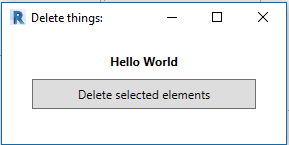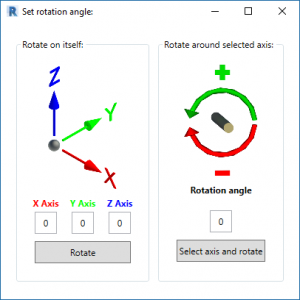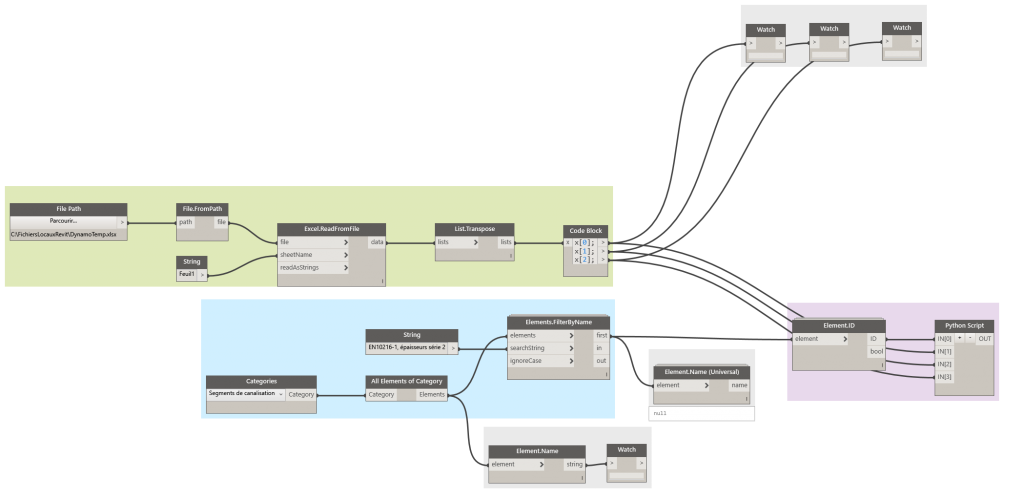Article non traduit actuellement, demandez la ou essayer la version anglaise ici (outil de traduction disponible) : http://pythoncvc.net/?p=283
Author Archives: Cyril Waechter
[Revit] Change objects reference level without moving it (Updated with a GUI)
Here is a new update of my [Revit] Change fittings reference level without moving it with :
- Updated to be used in pyRevit
- A new WPF GUI with a new option to select a level from your project list
- Better error handling which makes it easier to use
Find the short video tutorial here :
Full source code available here : https://github.com/CyrilWaechter/pyRevitMEP/tree/master/pyRevitMEP.tab/Tools.panel/ElementChangeLevel.pushbutton
Thanks a lot to :
- AngelSix for his great WPF tutorial
- Gui Talarico for his great «SelectFromList» example available in his RevitPythonWrapper
[Revit] Rotation d’objets dans toutes les directions
Article non traduit actuellement, demandez la ou essayer la version anglaise ici (outil de traduction disponible) : http://pythoncvc.net/?p=255
[Revit] Rotate elements in any direction script
More than 2 years ago I made an article to show a way to rotate element using Revit API. Using external events in a modeless form as described in my previous article you can for example make a GUI to get axis and angle from user inputs. It is also using ISelectionFilter as described in this previous article. The new thing is that I use a standard class to store rotation parameters. This way parameters are dynamically feed to methods which are run in external events.
Let’s see this in action :
Full source code with comments (designed to be used in pyRevit) :
from revitutils import doc, uidoc
from scriptutils.userinput import WPFWindow
# noinspection PyUnresolvedReferences
from Autodesk.Revit.DB import Transaction, ElementTransformUtils, Line, XYZ, Location, UnitType, UnitUtils
# noinspection PyUnresolvedReferences
from Autodesk.Revit.UI.Selection import ObjectType, ISelectionFilter
# noinspection PyUnresolvedReferences
from Autodesk.Revit.UI import IExternalEventHandler, IExternalApplication, Result, ExternalEvent, IExternalCommand
# noinspection PyUnresolvedReferences
from Autodesk.Revit.Exceptions import InvalidOperationException, OperationCanceledException
__doc__ = "Rotate object in any direction"
__title__ = "3D Rotate"
__author__ = "Cyril Waechter"
# Get current project units for angles
angle_unit = doc.GetUnits().GetFormatOptions(UnitType.UT_Angle).DisplayUnits
def xyz_axis(element_id):
"""Input : Element, Output : xyz axis of the element"""
origin = doc.GetElement(element_id).Location.Point
xyz_direction = [XYZ(origin.X + 1, origin.Y, origin.Z),
XYZ(origin.X, origin.Y + 1, origin.Z),
XYZ(origin.X, origin.Y, origin.Z + 1)]
axis = []
for direction in xyz_direction:
axis.append(Line.CreateBound(origin, direction))
return axis
class AxisISelectionFilter(ISelectionFilter):
"""ISelectionFilter that allow only which have an axis (Line)"""
# noinspection PyMethodMayBeStatic, PyPep8Naming
def AllowElement(self, element):
if isinstance(element.Location.Curve, Line):
return True
else:
return False
def axis_selection():
"""Ask user to select an element, return the axis of the element"""
try:
reference = uidoc.Selection.PickObject(ObjectType.Element, AxisISelectionFilter(), "Select an axis")
except OperationCanceledException:
pass
else:
axis = doc.GetElement(reference).Location.Curve
return axis
class RotateElement(object):
"""class used to store rotation parameters. Methods then rotate elements."""
def __init__(self):
self.selection = uidoc.Selection.GetElementIds()
self.angles = [0]
def around_itself(self):
"""Method used to rotate elements on themselves"""
try:
t = Transaction(doc, "Rotate around itself")
t.Start()
for elid in self.selection:
el_axis = xyz_axis(elid)
for i in range(3):
if self.angles[i] == 0:
pass
else:
ElementTransformUtils.RotateElement(doc, elid, el_axis[i], self.angles[i])
t.Commit()
except InvalidOperationException:
import traceback
traceback.print_exc()
except:
import traceback
traceback.print_exc()
def around_axis(self):
"""Method used to rotate elements around selected axis"""
try:
axis = axis_selection()
t = Transaction(doc, "Rotate around axis")
t.Start()
ElementTransformUtils.RotateElements(doc, self.selection, axis, self.angles)
t.Commit()
except InvalidOperationException:
import traceback
traceback.print_exc()
except:
import traceback
traceback.print_exc()
finally:
uidoc.Selection.SetElementIds(rotate_elements.selection)
rotate_elements = RotateElement()
# Create a subclass of IExternalEventHandler
class RotateElementHandler(IExternalEventHandler):
"""Input : function or method. Execute input in a IExternalEventHandler"""
# __init__ is used to make function from outside of the class to be executed by the handler. \
# Instructions could be simply written under Execute method only
def __init__(self, do_this):
self.do_this = do_this
# Execute method run in Revit API environment.
# noinspection PyPep8Naming, PyUnusedLocal
def Execute(self, application):
try:
self.do_this()
except InvalidOperationException:
# If you don't catch this exeption Revit may crash.
print "InvalidOperationException catched"
# noinspection PyMethodMayBeStatic, PyPep8Naming
def GetName(self):
return "Execute an function or method in a IExternalHandler"
# Create handler instances. Same class (2 instance) is used to call 2 different method.
around_itself_handler = RotateElementHandler(rotate_elements.around_itself)
around_axis_handler = RotateElementHandler(rotate_elements.around_axis)
# Create ExternalEvent instance which pass these handlers
around_itself_event = ExternalEvent.Create(around_itself_handler)
around_axis_event = ExternalEvent.Create(around_axis_handler)
class RotateOptions(WPFWindow):
"""
Modeless WPF form used for rotation angle input
"""
def __init__(self, xaml_file_name):
WPFWindow.__init__(self, xaml_file_name)
self.set_image_source("xyz_img", "XYZ.png")
self.set_image_source("plusminus_img", "PlusMinusRotation.png")
# noinspection PyUnusedLocal
def around_itself_click(self, sender, e):
try:
rotate_elements.selection = uidoc.Selection.GetElementIds()
angles = [self.x_axis.Text, self.y_axis.Text, self.z_axis.Text]
for i in range(3):
angles[i] = UnitUtils.ConvertToInternalUnits(float(angles[i]), angle_unit)
rotate_elements.angles = angles
except ValueError:
self.warning.Text = "Incorrect angles, input format required '0.0'"
else:
self.warning.Text = ""
around_itself_event.Raise()
# noinspection PyUnusedLocal
def around_axis_click(self, sender, e):
try:
rotate_elements.angles = UnitUtils.ConvertToInternalUnits(float(self.rotation_angle.Text), angle_unit)
rotate_elements.selection = uidoc.Selection.GetElementIds()
except ValueError:
self.warning.Text = "Incorrect angles, input format required '0.0'"
else:
around_axis_event.Raise()
RotateOptions('RotateOptions.xaml').Show()
Enjoy !
[Revit API] Exemple simple d’interface non modale (External Event Handler) dans pyRevit
Article non traduit actuellement, demandez la ou essayer la version anglaise ici (outil de traduction disponible) : http://pythoncvc.net/?p=247
[Revit API] Simple Modeless Form (External Event Handler) in pyRevit
 Warning : Some change in Revit API and Revit behaviour makes this article obsolete with newer version of Revit. I advise you to install pyRevitMEP extension and study updated code : FormExternalEventHandler.pushbutton. For usage in your script I recommend to use my CustomizableEvent from pyRevitMEP library.
Warning : Some change in Revit API and Revit behaviour makes this article obsolete with newer version of Revit. I advise you to install pyRevitMEP extension and study updated code : FormExternalEventHandler.pushbutton. For usage in your script I recommend to use my CustomizableEvent from pyRevitMEP library.
I struggled for a while to make a modeless form. Why did I need it ? Because each time I was trying to get user to select object after WPF appear I was going out of Revit API thread and got this very common exception «Autodesk.Revit.Exceptions.InvalidOperationException: Attempting to create an ExternalEvent outside of a standard API execution». As Jeremy Tammik says :
One of the most frequently raised questions around the Revit API is how to drive Revit from outside, e.g., from a separate thread, a modeless dialogue, or a stand-alone executable.
I have read many examples on the subject. Most on them were in C#.
- Some post pointed out the ModelessDialog sample available in Revit SDK : it helps me to understand how it should behave but it was still a bit too complex for my C# knowledge.
- This Building Coder’s article showed me a very simple example
- This Daren Thomas article showed me an ironpython example but a bit too complex for me
- This Daren Thomas answer on stackoverflow helped me better understand the concept
- This AEC DevBlog article make me wonder «Is my code really working or I missed something and I was only lucky in situation I tested ?»
So I made a very simple form to make a very simple ExternalEventHandler sample as pyRevit script. It will help me and I hope it will help some hackers to struggle less than I did.
Let’s start with common import statement using built-in pyRevit utils :
# noinspection PyUnresolvedReferences from Autodesk.Revit.UI import IExternalEventHandler, ExternalEvent # noinspection PyUnresolvedReferences from Autodesk.Revit.DB import Transaction # noinspection PyUnresolvedReferences from Autodesk.Revit.Exceptions import InvalidOperationException from revitutils import selection, uidoc, doc from scriptutils.userinput import WPFWindow __doc__ = "A simple modeless form sample" __title__ = "Modeless Form" __author__ = "Cyril Waechter"
Then let’s write a simple function we want to execute modeless (here it just delete selected elements) :
# Simple function we want to run def delete_elements(): t = Transaction(doc, "Failing script") t.Start() for elid in uidoc.Selection.GetElementIds(): print elid doc.Delete(elid) t.Commit()
And now come the new magic thing that let you enter in a valid Revit API context. The «ExternalEvent» class with his «IExternalEventHandler» class :
# Create a subclass of IExternalEventHandler
class SimpleEventHandler(IExternalEventHandler):
"""
Simple IExternalEventHandler sample
"""
# __init__ is used to make function from outside of the class to be executed by the handler. \
# Instructions could be simply written under Execute method only
def __init__(self, do_this):
self.do_this = do_this
# Execute method run in Revit API environment.
def Execute(self, uiapp):
try:
self.do_this()
except InvalidOperationException:
# If you don't catch this exeption Revit may crash.
print "InvalidOperationException catched"
def GetName(self):
return "simple function executed by an IExternalEventHandler in a Form"
# Now we need to make an instance of this handler. Moreover, it shows that the same class could be used to for
# different functions using different handler class instances
simple_event_handler = SimpleEventHandler(delete_elements)
# We now need to create the ExternalEvent
ext_event = ExternalEvent.Create(simple_event_handler)
Let’s do a simple form so easily created thanks to pyRevit in order to use our new toy :
# A simple WPF form used to call the ExternalEvent
class ModelessForm(WPFWindow):
"""
Simple modeless form sample
"""
def __init__(self, xaml_file_name):
WPFWindow.__init__(self, xaml_file_name)
self.simple_text.Text = "Hello World"
self.Show()
def delete_click(self, sender, e):
# This Raise() method launch a signal to Revit to tell him you want to do something in the API context
ext_event.Raise()
# Let's launch our beautiful and useful form !
modeless_form = ModelessForm("ModelessForm.xaml")
Here is the xaml code :
<Window xmlns="http://schemas.microsoft.com/winfx/2006/xaml/presentation" xmlns:x="http://schemas.microsoft.com/winfx/2006/xaml" Title="Delete things:" Height="150" Width="300" ShowInTaskbar="False" Topmost="True" WindowStartupLocation="CenterScreen" ScrollViewer.VerticalScrollBarVisibility="Disabled" HorizontalContentAlignment="Center"> <StackPanel Margin="20" HorizontalAlignment="Stretch"> <TextBlock x:Name="simple_text" Text="" Grid.Column="0" HorizontalAlignment="Center" FontWeight="Bold"/> <Button Content="Delete selected elements" Height="30" Margin="10,10" Click="delete_click"/> </StackPanel> </Window>
Thanks a lot to all people mentioned in this article and linked article and stuffs.
[Revit] Ajouter des tailles aux segments de tuyaux avec python + Dynamo + Excel
Article non traduit actuellement, demandez la ou essayer la version anglaise ici (outil de traduction disponible) : http://pythoncvc.net/?p=222
[Revit] Add sizes to a pipe segment using python + Dynamo + Excel
I didn’t want to use Dynamo as I really prefer line code programming to visual programming. But in fact Dynamo :
- has a very active community
- is open source too
- use python as main scripting language
- is great for debugging python script as you don’t need to include every single line in a try/except block
- is much user friendly than as it is now included with Revit 2017.1 and by the way this new Dynamo Player makes it usable by anyone
- scare many people less than line code so they can easily modify to adapt it to their objectives
Here is the Dynamo image. It uses Clockwork package :
File is available here
Here is the python code block :
import clr
clr.AddReference("RevitAPI")
from Autodesk.Revit.DB import *
from Autodesk.Revit.DB.Plumbing import PipeSegment
clr.AddReference("RevitServices")
from RevitServices.Persistence import DocumentManager
from RevitServices.Transactions import TransactionManager
doc = DocumentManager.Instance.CurrentDBDocument
#Les entrées effectuées dans ce noeud sont stockées sous forme de liste dans les variables IN.
dataEnteringNode = IN
elem = doc.GetElement(IN[0])
TransactionManager.Instance.EnsureInTransaction(doc)
for dn, di, de in zip(IN[1], IN[2], IN[3]):
DN = UnitUtils.ConvertToInternalUnits(dn , DisplayUnitType.DUT_MILLIMETERS)
Di = UnitUtils.ConvertToInternalUnits(di , DisplayUnitType.DUT_MILLIMETERS)
De = UnitUtils.ConvertToInternalUnits(de , DisplayUnitType.DUT_MILLIMETERS)
try:
elem.AddSize(MEPSize(DN,Di,De,True,True))
except:
elem.RemoveSize(DN)
elem.AddSize(MEPSize(DN,Di,De,True,True))
#Affectez la sortie à la variable OUT.
OUT = IN
Enjoy
[Revit] Supprimer les paramètres de projets y compris ceux cachés
Article non traduit actuellement, demandez la ou essayer la version anglaise ici (outil de traduction disponible) : http://pythoncvc.net/?p=201
[Revit] Delete parameters including hidden ones
In some case you need add or delete many parameters. Spiderinnet did many great articles about parameters, here are 2 of them :
Some Revit addins and extensions are adding many parameters to you project. Some are not even visible to the user. It means that you have to use API to remove it. In most common case you’ll never see it unless you use Revit Lookup. But when you export your model or do a duct pressure loss report it appears on it. So I made a script to get quickly rid of unwanted parameters (hidden or not).
from Autodesk.Revit.DB import *
from System import Guid
uidoc = __revit__.ActiveUIDocument
doc = __revit__.ActiveUIDocument.Document
app = __revit__.Application
#Retrieve all parameters in the document
params = FilteredElementCollector(doc).OfClass(ParameterElement)
filteredparams = []
#Store parameters which has a name starting with "magi" or "MC"
for param in params:
if param.Name.startswith(("magi", "MC")): #startswith method accept tuple
filteredparams.append(param)
print param.Name #To check if a parameter in the list is not supposed to be deleted
#Delete all parameters in the list
t = Transaction(doc, "Delete parameters")
t.Start()
for param in filteredparams:
doc.Delete(param.Id)
t.Commit()
Cheers !

